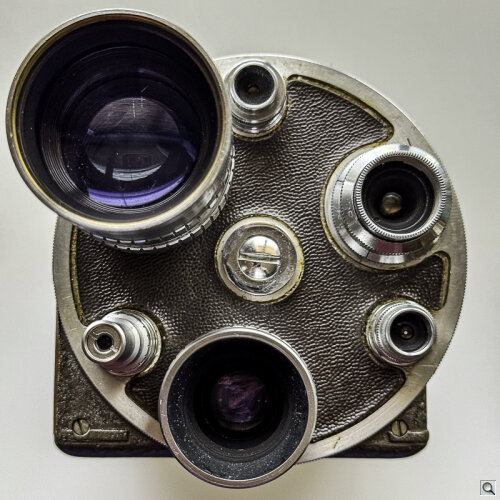Photo Corners headlinesarchivemikepasini.com
![]()
A S C R A P B O O K O F S O L U T I O N S F O R T H E P H O T O G R A P H E R
![]()
Enhancing the enjoyment of taking pictures with news that matters, features that entertain and images that delight. Published frequently.
Friday Slide Show: The Old Movie Camera



14 June 2024
When we say "old" we mean 1940s. And by the initial glued to the leather case, we understand it was our grandfather's movie camera. That's over 80 years old. In other words, old.
But it's a movie camera, not a stills camera. And as such it had more than a few technical hurdles to leap in 1941 or so. Which makes it more than a little interesting. Even amusing.
It was in the Goodwill pile at Mom's house but we thought we'd take a last look at it. Anybody (including us) with a smartphone wouldn't even be tempted to try to use it.
We're adverse to video anyway. We can't think of a more time-consuming waste of a life. It seems like every minute of video you capture costs you five times that in post production and screening. At least.
This old movie camera is a Bell & Howell 16mm Filmo Auto Master. It uses 50-foot film magazines, which were half the length of a spool of 16mm in those day.
It comes from the era before zoom lenses so its solution to being in the wrong place was to provide a turret with three lenses accompanied by viewfinder lenses. You switch to a different lens and what you see through the eyepiece changes. That's why you see six lenses on the turret.
Those two features distinguished the Filmo. It was the only movie camera that used magazines and had a turret. You could swap magazines on the fly (switch to black-and-white, say, and then back to color) without fogging a frame. And when you rotated to a different lens, the viewfinder automatically matched it.
This was also the era before batteries. So to power the unit, you wound the constant-speed spring drive. Once wound, you could use the shutter release to film. It had three settings: frame-by-frame, continuous while you held it down and locked (so you could set it and jump into the scene).
It was also the era before autofocus. Each lens had a distance scale engraved on it. The cameraman (who no doubt had some practice with this on the golf course) had to estimate the distance from his subject to get it in focus.
Gramp had quite the package in that case with compensating filters for the lenses, a lens shade, a chrome handle, a carrying strap and a small envelope of various items like lens caps.
He passed it on to Dad to film our birthdays and graduations before Dad, tired of the complaints about cutting heads off and weary from buying and processing film, went video.
Perhaps one should never look back. Today's phones do indeed make video camcorder technology look like cruel and unusual punishment even with their batteries, zooms and autofocus.
But we couldn't help but admire the innovations of this Filmo and its meticulous engineering. It makes today's innovations and engineering look like short cuts.
But we would say that, being old ourselves.
